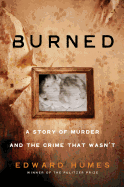
Late one April night in 1989, Shirley Robinson opened her door to find neighbor Jo Ann Parks framed by the orange glow of a fire behind her. Parks's converted rental apartment was engulfed in flames; she escaped but her three young children perished in the intense blaze. Fire investigators concluded that Parks set the fire with the intent of killing her children and she was sentenced to life in prison. But was she a monster or the victim of flawed science?
In Burned, Pulitzer Prize-winner Edward Humes (Garbology, Monkey Girl) questions Parks's conviction based on flaws in fire science and in the criminal justice system. Arson is "the one criminal act that consumes rather than creates" evidence, and an accidental fire can easily be interpreted as arson. Was the fact that Parks's previous house also caught fire relevant to the investigation? Did investigators ignore the damage caused by flashover, which turns "a fire in a room into a room on fire?" Is "negative corpus," which insists on the cause of a fire when other possibilities have been eliminated, valid even in the absence of physical evidence? Did investigators ignore advances in fire science and draw biased conclusions?
These questions were enough for the California Innocence Project (CIP) to take Parks's case. In 2018, under habeas corpus, Parks and CIP were granted a hearing to challenge the initial investigators' findings as discredited "junk science" that masqueraded for forensic science (but is still widely practiced). Humes shows how the story of Jo Ann Parks wrongful conviction has the power to upend arson investigation as we know it. --Frank Brasile, librarian

